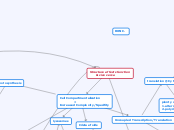作者:Ron Chertakovsky 8 年以前
264
Biology Extra Credit

作者:Ron Chertakovsky 8 年以前
264

更多类似内容
Regulates whether or not M phase occurrs
Allows for S phase to proceed
Signal Transduction Pathway
Possible transcription factor cellular response post Signal Transduction Pathway
right next to highly energetic a pair e- result: maximizing oxidative power
Phostosystems are Integral Proteins!
Integrins facilitate ECM>cytoplasm contact
pigment molecules positioned in a cluster maximize e- energy release in order to truly excite P680/700 of reaction complex
Stroma>Thylakoid space>Stroma direction of ATP formation
ATP deposited where needed the most by stroma occurring Calvin Cycle
constant supply of e- to PSII
minimizing photorespiration
kinetochore microtubule + motor protein separation of homologs & chromatids
kinetochore microtubule + motor protein separation of chromatids
All Genetic Information is expressed/transferred in a Regulated Manner
Cell Division
Meiotic Division: Result= haploid division of germ cells
Mitotic division: Result= diploid division of somatic cells
eukaryotic regulation
transcription factor-control sequence
eukaryotic coordinated control
Parallels to
chromatin folding @ nucleus
prokaryotic regulation
prokaryotic operon
plenty of space for 1. alternative splicing 2. polyribozymatic translation